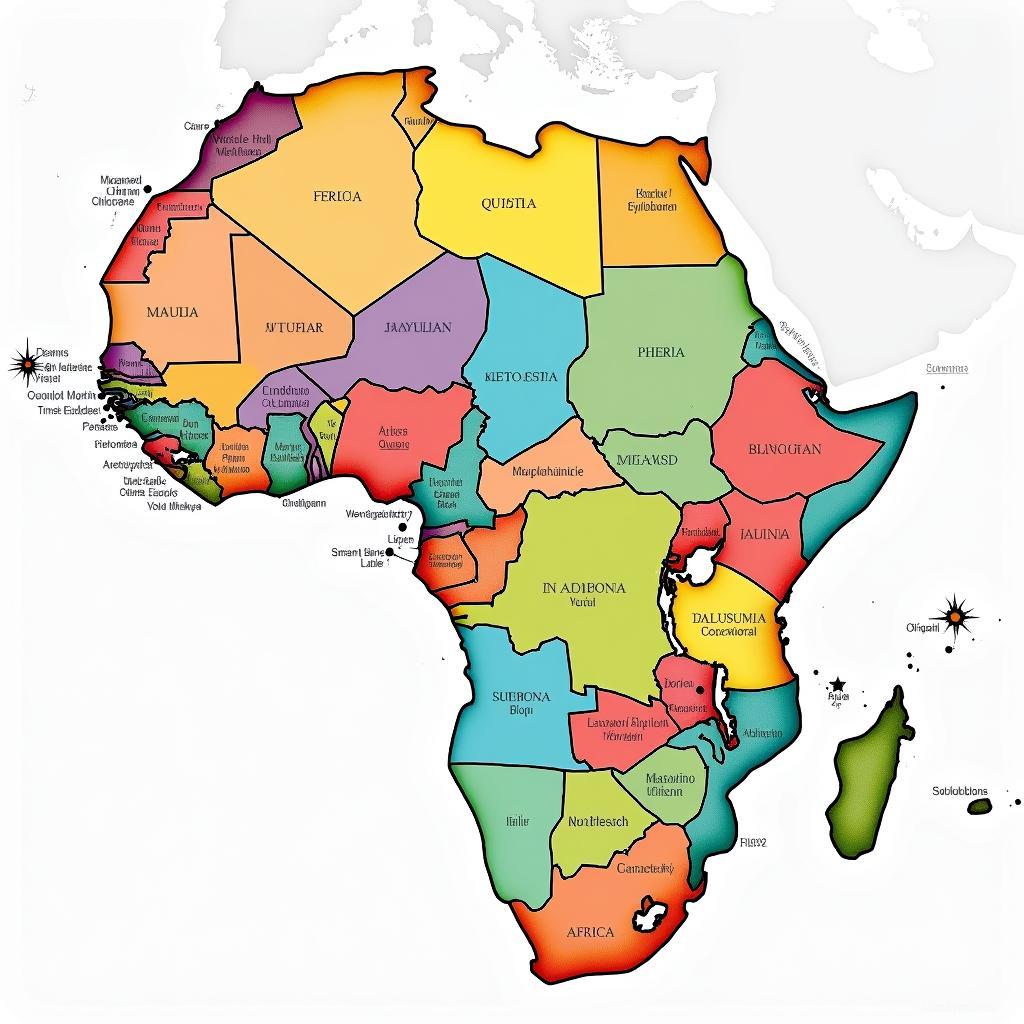What African Grasslands Are Called
African grasslands, often envisioned with iconic acacia trees silhouetted against a setting sun, are called savannas. The term “savanna” originates from the Spanish word “sabana,” ultimately derived from the Taino indigenous word “zabana.” This word signifies a treeless plain, although the African savanna is characterized by a mix of grasses and trees, creating a unique and diverse ecosystem.
Savannas cover vast stretches of Africa, forming a crucial part of the continent’s landscape. They are known for their diverse wildlife, including large herds of herbivores like zebras and wildebeest, and the predators that hunt them, such as lions and cheetahs. This complex web of life is intricately connected to the savanna’s defining feature: the delicate balance between grass and trees. See our article on the African elephant, one of the Big Five, for more on the continent’s remarkable animals. african elephant big five
Understanding the African Savanna Ecosystem
The name “savanna” encompasses a variety of grassland ecosystems, each with unique characteristics determined by factors like rainfall, soil type, and fire frequency. These variations create a mosaic of habitats within the broader savanna biome, each supporting diverse plant and animal communities. The defining characteristic of the savanna is its open canopy, allowing sufficient sunlight to reach the ground and sustain the dominant vegetation: grasses.
What are the different types of African savannas?
There are several distinct types of savannas across Africa, each characterized by the density and distribution of trees. These include:
- Tree savannas: Characterized by a higher density of trees, often forming woodland-like areas.
- Shrub savannas: Dominated by shrubs and scattered trees.
- Grass savannas: Primarily composed of grasses with very few trees.
These diverse savanna types contribute to the overall biodiversity of the African continent, providing habitats for a vast array of species. The savanna’s ecological balance is maintained by complex interactions between fire, grazing, and rainfall patterns, creating a dynamic and ever-changing landscape.
The Role of Fire in Shaping the Savanna
Fire plays a vital role in maintaining the savanna’s unique blend of grasses and trees. Regular fires, often ignited by lightning strikes, prevent the encroachment of trees and shrubs, allowing grasses to thrive. This cyclical process of burning and regrowth shapes the savanna’s vegetation structure and influences the distribution of animal populations. Check out our article on the African fire tree for information on a tree species well-adapted to fire. african fire tree
How does fire benefit the savanna?
- Nutrient Cycling: Fire releases nutrients locked up in dead plant matter back into the soil, enriching it for new growth.
- Seed Germination: Some plant species require fire to trigger seed germination, promoting biodiversity.
- Grazing Opportunities: New growth following a fire provides fresh, nutritious forage for grazing animals.
Dr. Amina Kenyatta, a renowned ecologist specializing in African savannas, emphasizes the crucial role of fire. “Fire is not a destructive force in the savanna, but rather a vital component of its ecological balance. It’s an integral part of the natural cycle that sustains the biodiversity of this unique ecosystem.”
The Wildlife of the African Savanna
The African savanna is renowned for its abundant wildlife, from large herds of herbivores like zebras, wildebeest, and elephants to the predators that prey on them, including lions, cheetahs, and leopards. This rich fauna is adapted to the savanna’s open spaces and fluctuating resources, contributing to its vibrant and dynamic ecosystem. You can find more information on where African bears live in our dedicated article. african bear habitat
What animals are found in the African savanna?
The savanna supports a vast array of animal life, including:
- Herbivores: Elephants, giraffes, zebras, wildebeest, antelopes
- Carnivores: Lions, cheetahs, leopards, hyenas, wild dogs
- Birds: Ostriches, vultures, eagles, secretary birds
Professor Musa S. Kileo, a wildlife biologist with decades of experience researching African fauna, notes, “The savanna’s vast open spaces and diverse vegetation provide ideal habitats for a remarkable array of animal species. The interplay between predator and prey, grazers and the vegetation, is a spectacle of nature’s intricate balance.”
The Future of the African Savanna
The African savanna faces increasing pressure from human activities, including habitat loss, poaching, and climate change. Conservation efforts are crucial to protect this unique ecosystem and its biodiversity for future generations. african grasslands are called african grasslands are called examveda
In conclusion, African grasslands are called savannas, a vibrant ecosystem shaped by fire, grazing, and rainfall. Protecting this unique landscape and its diverse wildlife is crucial for maintaining the ecological balance of Africa and preserving its natural heritage.
FAQ
- What is the main vegetation type in African savannas? Grass.
- What is the role of fire in the savanna? It maintains the balance between grasses and trees.
- What are some of the iconic animals of the African savanna? Lions, elephants, zebras, giraffes.
- What are the threats to the African savanna? Habitat loss, poaching, and climate change.
- Why are African savannas important? They support a high level of biodiversity.
- What is the origin of the word “savanna”? It comes from the Taino word “zabana.”
- What are the different types of African savannas? Tree, shrub, and grass savannas.
When you need support, please contact us: Phone: +255768904061, Email: kaka.mag@gmail.com, or visit our address: Mbarali DC Mawindi, Kangaga, Tanzania. We have a 24/7 customer support team.

